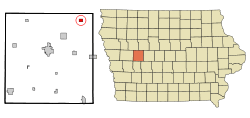Lanesboro, Iowa
| Lanesboro, Iowa | |
|---|---|
| City | |
 Location of Lanesboro, Iowa | |
| Coordinates: 42°11′3″N 94°41′33″W / 42.18417°N 94.69250°WCoordinates: 42°11′3″N 94°41′33″W / 42.18417°N 94.69250°W | |
| Country |
|
| State |
|
| County | Carroll |
| Area[1] | |
| • Total | 0.75 sq mi (1.94 km2) |
| • Land | 0.74 sq mi (1.92 km2) |
| • Water | 0.01 sq mi (0.03 km2) |
| Elevation | 1,142 ft (348 m) |
| Population (2010)[2] | |
| • Total | 121 |
| • Estimate (2012[3]) | 120 |
| • Density | 163.5/sq mi (63.1/km2) |
| Time zone | Central (CST) (UTC-6) |
| • Summer (DST) | CDT (UTC-5) |
| ZIP code | 51451 |
| Area code(s) | 712 |
| FIPS code | 19-43140 |
| GNIS feature ID | 0458219 |
Lanesboro is a city in Carroll County, Iowa, United States. The population was 121 at the 2010 census.
History
Lanesboro had its start in the year 1901 by the building of the Mason City and Fort Dodge Railroad through that territory. It was named for Julius Lane, an early settler.[4]
Geography
Lanesboro is located at 42°11′03″N 94°41′33″W / 42.184035°N 94.692460°W.[5]
According to the United States Census Bureau, the city has a total area of 0.75 square miles (1.94 km2), of which, 0.74 square miles (1.92 km2) is land and 0.01 square miles (0.03 km2) is water.[1]
Demographics
| Historical populations | ||
|---|---|---|
| Year | Pop. | ±% |
| 1910 | 268 | — |
| 1920 | 282 | +5.2% |
| 1930 | 270 | −4.3% |
| 1940 | 289 | +7.0% |
| 1950 | 280 | −3.1% |
| 1960 | 258 | −7.9% |
| 1970 | 203 | −21.3% |
| 1980 | 196 | −3.4% |
| 1990 | 182 | −7.1% |
| 2000 | 152 | −16.5% |
| 2010 | 121 | −20.4% |
| 2014 | 116 | −4.1% |
| 2015 | 116 | +0.0% |
| Source:"American FactFinder". United States Census Bureau. and Iowa Data Center Source: | ||
2010 census
As of the census[2] of 2010, there were 121 people, 62 households, and 33 families residing in the city. The population density was 163.5 inhabitants per square mile (63.1/km2). There were 74 housing units at an average density of 100.0 per square mile (38.6/km2). The racial makeup of the city was 95.9% White, 0.8% African American, 0.8% Asian, and 2.5% from two or more races. Hispanic or Latino of any race were 3.3% of the population.
There were 62 households of which 17.7% had children under the age of 18 living with them, 48.4% were married couples living together, 4.8% had a female householder with no husband present, and 46.8% were non-families. 37.1% of all households were made up of individuals and 9.7% had someone living alone who was 65 years of age or older. The average household size was 1.95 and the average family size was 2.61.
The median age in the city was 50.8 years. 15.7% of residents were under the age of 18; 7.4% were between the ages of 18 and 24; 15.8% were from 25 to 44; 43% were from 45 to 64; and 18.2% were 65 years of age or older. The gender makeup of the city was 52.9% male and 47.1% female.
2000 census
As of the census[7] of 2000, there were 152 people, 71 households, and 42 families residing in the city. The population density was 204.5 people per square mile (79.3/km²). There were 77 housing units at an average density of 103.6/sq mi (40.2/km²). The racial makeup of the city was 98.68% White, 0.66% from other races, and 0.66% from two or more races. Hispanic or Latino of any race were 0.66% of the population.
There were 71 households out of which 23.9% had children under the age of 18 living with them, 53.5% were married couples living together, 2.8% had a female householder with no husband present, and 40.8% were non-families. 36.6% of all households were made up of individuals and 16.9% had someone living alone who was 65 years of age or older. The average household size was 2.14 and the average family size was 2.83.
In the city the population was spread out with 19.7% under the age of 18, 7.2% from 18 to 24, 27.0% from 25 to 44, 27.6% from 45 to 64, and 18.4% who were 65 years of age or older. The median age was 43 years. For every 100 females there were 120.3 males. For every 100 females age 18 and over, there were 117.9 males.
The median income for a household in the city was $25,750, and the median income for a family was $31,250. Males had a median income of $30,000 versus $20,625 for females. The per capita income for the city was $15,397. About 5.9% of families and 10.8% of the population were below the poverty line, including none of those under the age of eighteen and 17.6% of those sixty five or over.
References
- 1 2 "US Gazetteer files 2010". United States Census Bureau. Retrieved 2012-05-11.
- 1 2 "American FactFinder". United States Census Bureau. Retrieved 2012-05-11.
- ↑ "Population Estimates". United States Census Bureau. Retrieved 2013-05-23.
- ↑ Maclean, Paul (1912). History of Carroll County, Iowa: A Record of Settlement, Organization, Progress and Achievement, Volume 1. S. J. Clarke Publishing Company. p. 246.
- ↑ "US Gazetteer files: 2010, 2000, and 1990". United States Census Bureau. 2011-02-12. Retrieved 2011-04-23.
- ↑ "Census of Population and Housing". Census.gov. Retrieved June 4, 2015.
- ↑ "American FactFinder". United States Census Bureau. Retrieved 2008-01-31.